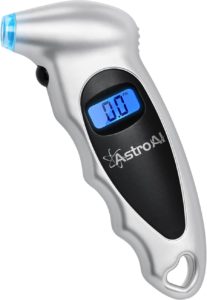Volkswagen Tiguan TPMS Description
The Volkswagen Tiguan features a tire pressure monitoring system (TPMS) that notifies the driver if the pressure in any of the tires falls below the optimal level. To gauge tire pressure indirectly while the vehicle is in motion, the Tiguan relies on its Anti-lock Brake System (ABS) wheel speed sensors.
How Does the Volkswagen TPMS Work?
ABS sensors transmit data to the vehicle’s computer.
The computer determines the speed of each wheel.
Speed discrepancies due to under-inflation are identified.
The ABS system adjusts and sends an alert to the driver via TPMS warning light on the dashboard.
The warning light Indicates low tire pressure.
Enables early detection to prevent hazardous situations.
Indirect TPMS enhances overall safety.
In a Volkswagen Tiguan, the indirect Tire Pressure Monitoring System (TPMS) operates by utilizing the vehicle’s existing Anti-lock Brake System (ABS) sensors to monitor the tire pressure indirectly. These ABS sensors are strategically placed behind each wheel, constantly measuring the rotational speed of each tire as the vehicle moves. When a tire is under-inflated, its rolling circumference changes, causing it to rotate at a different speed compared to a properly inflated tire. The vehicle’s computer analyzes the data from the ABS sensors and detects any discrepancies in wheel speed. If the system identifies an unusual deviation in the speed of one or more wheels, it interprets this as a potential drop in tire pressure. Consequently, the indirect TPMS triggers a warning alert on the dashboard, notifying the driver of the possible low tire pressure. This early detection allows the driver to address the issue before it becomes dangerous, ensuring a safer driving experience and improved fuel efficiency.
Volkswagen Tiguan Tire Pressure Light Reset Procedure:
Fill the tires to the recommended pressures. (found on the driver side door jamb, yellow sticker)
Turn the vehicle to the ON position or have the vehicle running.
Select the CAR button.
Select SETTINGS.
Select TIRES.
Select SET under “tire pressure monitoring system”.
Select CONFIRM.
2022 - PRESENT VOLKSWAGEN TIRE RESET
What Happens When Tires are Underinflated?
When the tires of a Volkswagen Tiguan are under-inflated, several unfavorable consequences can arise. Under-inflated tires have a larger contact area with the road, leading to increased friction and uneven wear on the tire tread. This uneven wear can compromise the overall performance, handling, and safety of the vehicle. In addition, under-inflated tires generate excessive heat as they flex more than intended, which can result in premature tire degradation or even a sudden blowout. Furthermore, the Tiguan’s fuel efficiency is negatively impacted by under-inflated tires, as the engine must work harder to overcome the increased rolling resistance. Lastly, the improper inflation of tires can adversely affect the vehicle’s braking system and stability, making it more challenging for the driver to maintain control during turns and sudden maneuvers. It is crucial to regularly monitor tire pressure and maintain proper inflation levels to ensure a safe and efficient driving experience.
What Causes a Low Tire Pressure Light in the VW Tiguan?
Low tire pressure: One or more tires are under-inflated.
Tire puncture: A sharp object has penetrated the tire, causing a leak.
Seasonal temperature changes: Cold weather can cause tire pressure to drop.
Tire rotation: Incorrect tire rotation procedure or mismatched tire sizes.
Wheel alignment issues: Misaligned wheels can affect tire pressure monitoring.
Faulty ABS sensor: Malfunctioning or damaged ABS sensors can trigger false alerts.
Faulty wheel speed sensor: broken or malfunctioning wheel speed sensors will cause the tire warning lights
Tire replacement: New or different tires with varying rolling circumferences. (mismatched tire sizes)
Damaged wheels: Bent or damaged wheels can affect tire pressure readings.
Calibration needed: TPMS may require recalibration after tire pressure adjustments.
Electrical issues: Wiring or connection problems related to the ABS or TPMS system.
When to Recalibrate the TPMS?
After tire inflation: When adjusting tire pressure to recommended levels.
Following tire rotation: When tires have been rotated as part of regular maintenance.
After wheel balance: Everytime the tires are balanced
Upon tire replacement: When installing new or different tires on the vehicle.
After wheel alignment: When the vehicle’s wheels have been aligned or adjusted.
Seasonal changes: When transitioning between seasons with significant temperature fluctuations.
After wheel repair or replacement: When damaged wheels have been repaired or replaced.
TPMS warning light: When the TPMS warning light comes on without an apparent cause.
Manufacturer’s recommendation: When suggested by the vehicle’s maintenance schedule or owner’s manual.
Post a flat tire repair: After repairing a punctured tire and reinstalling it on the vehicle.
Major suspension work: Following any significant work on the vehicle’s suspension system.
Tire Maintenance
Always make adjustments to tire pressure when the tires are cold! Temperature fluctuations greatly influence tire pressure, with colder tires exhibiting lower pressure as a result of contraction and warm tires displaying higher pressure due to expansion. The suggested tire pressure values by volkswagen, rely on readings taken from cold tires. Inflating warm or hot tires may result in over-inflation, increasing the risk of a sudden tire blowout or rapid tread wear. Assessing tire pressure when they’re cool guarantees precise pressure levels, which in turn promotes prime vehicle performance and safety. Basically, be sure to check tire pressure when they’re cold, either before driving or after the vehicle has been stationary for a considerable period.



